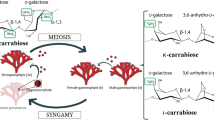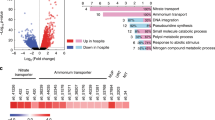Abstract
THE exact ways in which endosymbiotic algae serve their host tissues have been the subject of much research in the past 10 years. The view that the algae contribute to the nutrition of the host has gained much support from studies using radioactive tracers. Algae were shown to contribute material labelled with carbon-14 when the co-elenterate host (anemone1, coral2 or hydra3) was exposed to 14CO2 in the light. Muscatine has shown that algae isolated from hydra4 and from other freshwater invertebrates5 leak 14C-maltose into the media. The questions remain whether the algae release glucose or maltose in vivo, and in what way do the hydra utilize these compounds. We describe here experiments which show that the animal tissue of Chlorohydra viridissima incorporates a large proportion of the small molecules produced by their endosymbiotic algae during photosynthesis, and that most of these small molecules are converted by hydra into polysaccharide.
This is a preview of subscription content, access via your institution
Access options
Subscribe to this journal
Receive 51 print issues and online access
$199.00 per year
only $3.90 per issue
Buy this article
- Purchase on Springer Link
- Instant access to full article PDF
Prices may be subject to local taxes which are calculated during checkout
Similar content being viewed by others
References
Muscatine, L., and Hand, C., Proc. US Nat. Acad. Sci., 44, 1259 (1958).
Goreau, T. F., and Goreau, M. I., Science, 131, 668 (1960).
Muscatine, L., and Lenhoff, H. M., Science, 142, 956 (1963).
Muscatine, L., Comp. Biochem. Physiol., 16, 77 (1965).
Muscatine, L., Karakashian, S. J., and Karakashian, M. W., Comp. Biochem. Physiol., 20, 1 (1967).
Loomis, W. F., and Lenhoff, H. M., J. Exp. Zool., 132, 555 (1956).
Muscatine, L., and Lenhoff, H. M., Biol. Bull., 128, 415 (1965).
Roberts, R., Abelson, P., Cowle, D., Bolton, E., and Britten, R., Carnegie Inst., Wash. Publ., 607 (1957).
Rutherford, C., and Lenhoff, H. M., Arch. Biochem. Biophys. (in the press).
Powers, D., Lenhoff, H. M., and Leone, C., Comp. Biochem. Physiol., 27, 139 (1968).
Author information
Authors and Affiliations
Rights and permissions
About this article
Cite this article
ROFFMAN, B., LENHOFF, H. Formation of Polysaccharides by Hydra from Substrates produced by their Endosymbiotic Algae. Nature 221, 381–382 (1969). https://doi.org/10.1038/221381a0
Received:
Revised:
Issue Date:
DOI: https://doi.org/10.1038/221381a0
This article is cited by
Comments
By submitting a comment you agree to abide by our Terms and Community Guidelines. If you find something abusive or that does not comply with our terms or guidelines please flag it as inappropriate.



